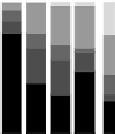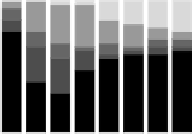Graphics Reference
In-Depth Information
Figure
.
.
Summary of pain relief responses over time for different doses from a clinical trial with
unignorable dropout. In each summary bar, the shadings from bottom to top indicate “no pain relief”
through intermediate levels up to “complete pain relief.” he graphs in the top row only include the
people that have not dropped out (the widths of the histogram bars are proportional to the number of
subjects remaining at each time point). he graphs in the bottom row include everybody, with imputed
responses for the dropouts. he bottom row of plots - which are based on complete data sets - are
much more directly interpretable than the observed-data plots on the top row
he existence of an explicit underlying model is beneficial in that it suggests ex-
ploratory plots that address the fit of the data to whichever model is being fitted to
them. Placing EDA within the general theory of model-checking potentially enables
graphical methods to become a more acceptable presence in statistical modeling.
Our approach is to use statistical graphics in all stages of data analysis: model-
building, model-fitting, model-checking and model-understanding. In all stages of
dataanalysis,weneedmodel-checkingtoolssothatwecanseethefaultsandshort-
comings in our model. Understanding complex probability models oten requires
complextools.Simpleteststatisticsand p-valuesjustdonotsu
ce,soweneedgraphs
to aid us. More oten than not we need to customize the graphs to the problem; we
are not usually satisfied with a standard graph. However, new and better standard
methods of graphical display need to be developed.
Considering that graphs areequivalent tomodelchecks,“exploratory” data analy-
sisisnotdoneonlyatthebeginningofthemodelingprocess;themodelisre-explored
at each stage ater model fitting. he construction of a new, complex model may re-
sultinunforeseen problemsduringthefitting; inanticipation ofthese,weexplorethe
fitted modelwith standard and customizedstatistical graphs that are then used to at-
tempt to falsify the model and to find ways to improve it, or to discard it completely
and start all over again. It is also standard for our practice not to perform model-



































































